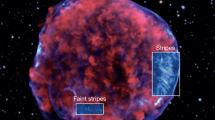Abstract
A REMARKABLE change in the X-ray spectrum of the transient source A0620—00 (ref. 1) was observed by the Ariel V Sky Survey Experiment (SSE) during the rise to maximum brightness, The SSE detector being used has an effective area (behind its field collimator) of 290 cm2 and covers the energy band 2–18 keV in 8 channels. The channel boundaries are marked in Fig. 1, which shows sample pulse height spectra taken as the source intensified. These raw data have not been corrected for the detector efficiency and at this stage include no input spectral assumptions. Two points emerge clearly: when first detected the X-ray spectrum of A0620—00 was hard and remained so as the overall intensity rose to the precursor peak and, secondly, the subsequent rise to maximum intensity was entirely due to a strong enhancement of X rays below 10 keV, giving a marked softening in the overall spectrum. In fact, the observed flux above 10 keV actually fell during this period.
This is a preview of subscription content, access via your institution
Access options
Subscribe to this journal
Receive 51 print issues and online access
$199.00 per year
only $3.90 per issue
Buy this article
- Purchase on Springer Link
- Instant access to full article PDF
Prices may be subject to local taxes which are calculated during checkout
Similar content being viewed by others
References
Elvis, M., Page, C. G., Pounds, K. A., Ricketts, M. J., and Turner, M. J. L. Nature, 257, 656–657 (1975).
Author information
Authors and Affiliations
Rights and permissions
About this article
Cite this article
RICKETTS, M., POUNDS, K. & TURNER, M. The X-ray spectrum of A0620—00. Nature 257, 657–658 (1975). https://doi.org/10.1038/257657a0
Received:
Accepted:
Issue Date:
DOI: https://doi.org/10.1038/257657a0
This article is cited by
-
Second catalogue of X-ray sources
Astrophysics and Space Science (1982)
-
X-ray transient sources
Astrophysics and Space Science (1979)
-
Ionization effects from cosmic sources of x-rays in the lower atmosphere
Proceedings / Indian Academy of Sciences (1978)
-
Critical accretion flow of gas onto compact stars
Astrophysics and Space Science (1977)
-
Spectral characteristics of transient X-ray sources
Nature (1976)
Comments
By submitting a comment you agree to abide by our Terms and Community Guidelines. If you find something abusive or that does not comply with our terms or guidelines please flag it as inappropriate.



